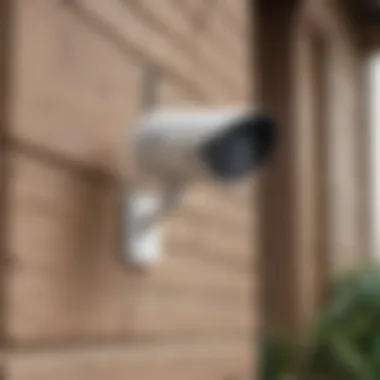Exploring Cutting-Edge Wireless Home Security Systems


Intro
In contemporary society, the conversation surrounding home security has shifted significantly. The shift has moved from traditional hardwired systems to more versatile wireless options. These innovations offer users increased flexibility, enhanced features, and easy accessibility through smartphones. Thus, many homeowners now consider wireless systems essential for a protecting their property.
This article highlights key aspects of wireless home security systems, including vital features that influence the market. It presents different options, ranging from basic surveillance setups to advanced integrations with smart home technology. Readers will gain insights that prepare them to make educated decisions regarding their own home security needs.
Overview of Wireless Home Security Systems
Understanding Wireless Technology
At the core of wireless security systems is the use of RF (radio frequency) technology, which enables cameras, alarms, and sensors to communicate without tedious wiring. By eliminating the complexities of installation and configuration associated with older systems, modern owners have adaptive options at their disposal.
Prelude to Wireless Home Security
Wireless home security systems provide protection to homes using advanced technology without the need to run wires, offering convenience and flexibility. In today’s fast-paced world, the importance of a reliable security system cannot be overstated. Safety is a paramount concern for many homeowners. Understanding the underlying technology and features helps consumers make informed decisions.
Understanding Wireless Security
Wireless security employs a range of devices including cameras, sensors, and alarms, all of which are connected wirelessly. These components work together to provide a comprehensive view of your property. One major aspect that makes wireless systems appealing is the installation process. Unlike traditional systems, there is no need to drill walls or install extensive sequences of wiring. This significantly lowers installation time and costs.
Furthermore, wireless models utilize protocols such as Wi-Fi or cellular connections. These protocols ensure successful communication between devices which can enable, for example, real-time notifications about security events.
Advantages Over Traditional Systems
Wireless systems stand out for several reasons. Firstly, ease of installation remains the primary advantage. A simple DIY setup allows homeowners to take control of their security. Users can set up the system as per their unique needs and can further expand it by adding more devices dynamically.
Security enhancements provide added appeal. Many wireless systems use sophisticated encryption methods to secure data transmission. This protects privacy and ensures that sensitive information about the property remains confidential.
Moreover, mobile connectivity also grants remote management options. Users can monitor their home live through mobile applications. This makes it effortless to check in when distance separates you from home.
Key Features of Wireless Home Security Systems
Wireless home security systems have gained considerable attention in recent years. The convenience and flexibility afforded by these technologies simplify the task of safeguarding residences. Comprehending such vital features is essential when choosing the optimal system for a home.
Cameras and Surveillance Options
Cameras play a pivotal role in home security. These devices allow for real-time monitoring of properties, enabling homeowners to perceive potential threats swiftly. High-definition cameras offer clearer images while features like night vision ensure functionality even in low-light conditions.
Modern wireless systems often include options for remote access. This feature permits the user to manage camera feeds directly from mobile devices, an attractive characteristic for avid smartphone users. Integration with cloud storage also facilitates recording without the need for extensive hardware. Additional capabilities, such as movement tracking and two-way communication, add valuable layers to user experience.
It's also essential to consider the location of these cameras. Indoor and outdoor models differ significantly in material and tech specifications. For durable outdoor cameras, weatherproofing features are crucial, as exposure to elements can cause damage and hinder operational eficiency.
Motion Detectors and Sensors
Motion detectors are critical in identifying unusual activity around a property. They operate based on infrared technology. This helps detect temperature changes in the environment to recognize movement efficiently. Some systems allow for mobile alerts when any movement is detected
Having a system with both indoor and outdoor sensors offers broader coverage. Installing outdoor sensors can prevent unauthorized access before it manifests, providing real-time alerts and possibly deterring criminals. However, improper placement can cause false alarms from pets or other dynamic elements, potentially leading to annoyance.
Selecting a system where sensors can adapt their sensitivity settings enhances usability. Homeowners can fine-tune these settings based on experience, effectively honing device reactivity in specific zones.
Alarm Systems and Notifications
Alarm systems fundamentally underpin the effectiveness of wireless home security systems. Behavioral response mechanisms are vital aspects that homeowners must consider. Alarms pulse loudly to warn the property owners instantly of any suspicious activity. Many systems also integrate notifications that alert customers via mobile apps.
Notifications vary from emergency alerts from sensor usage to camera captures. These notifications reinforce the sense of security by ensuring that the user is not solely reliant on passive monitoring. Instead, they can actively manage live scenarios regardless of their distance from their homes.
Some cutting-edge systems feature automatic emergency services notification, which streamlines the process should an unauthorized breach occur. With instant communication between the user and authorities, damage or theft can be mitigated, improving response times significantly. Ensuring that the chosen alarm systems provide detailed reports adds value for post-event analysis, creating smarter strategies for future proprietorship management.


"Investing in robust wireless features does not only ensure the security of your home but also transforms it into a modernized hub for protection and accessibility."
Types of Wireless Home Security Systems
Understanding the types of wireless home security systems is crucial for anyone looking to enhance their home safety. Each system type offers unique features and benefits, helping users tailor security measures to their specific needs. Assessing the options can ensure users select the right solutions that align with personal preferences and budgets.
DIY Wireless Security Kits
DIY wireless security kits provide flexibility and accessibility. These kits generally include essential equipment such as cameras, sensors, and alarms. Homeowners have the power to install and customize their systems without needing professional help. One significant advantage is cost savings—not only in terms of equipment but also on professional installation fees.
These kits are particularly appealing for individuals who prefer hands-on project. Users can adjust the system placement and configurations according to their property's demands. Also, as technology has progressed, many kits come with user-friendly applications that allow monitoring from smartphones.
According to some studies, 69% of consumers feel confident with DIY systems. This statistic showcases the growing confidence in these approaches mas home security is now more accessible than before.
- Performance often depends on the user's technical know-how
- These systems will require regular updates and maintenance
Professionally Monitored Systems
Time pressed individuals or those seeking peace of mind may prefer professionally monitored systems. These systems often s feature advanced monitoring services from companies that oversee the security setups. They send real-time alerts in case of suspicious activity, ensuring immediate and trained response.
Investing in professional monitoring typically results in comprehensive support. The service equips the system with various devices, communicates, and resolves potential safety issues quickly to the authorities. Effectively, these systems can limit damages and compromised safety as they actively represent a professional safety net.
These systems allow integration with several advanced devices, producing data patterns users can analyze physically or digitally. Reviews often highlight the efficiency of handled alerts through dedicated customer teams.
- Companies often provide different service tiers to budget varying levels of protection
- Responsiveness can ultimately scale with immediate task force readiness, boosting security reliability
Smart Home Integration
Smart home integration represents a progressive direction for security systems. This refers to the interchange between wireless home security and other home automation technologies. Such configurations create interconnected eco-systems combining lighting, heating, and surveillance into a singular platform managed easily through smartphones.
These integrated systems confer not only tp-of-the-line security but also enrich overall lifestyle experience. For instance, with smart monitoring features, users can observe home surroundings even when away. Furthermore, linking smart locks handles door access restrictions efficiently right within the connected tone covered by the overall Wi-Fi network.
Investing in smart home technology automates routines, situations and secures assets while preserving comfort and accessibility avenues highly sought today.
- Choose products compatible with protocols such as Z-Wave or Zigbee for seamless communication
- Prioritize privacy measures within smart home systems to prevent unauthorized data access
With multiple options in wireless home security, the approach one takes can define the desired outcomes immensely, adequately fitting underside diverse needs within the immediate environment to future-proof solutions.
How to Choose the Right Wireless Security System
Choosing a wireless security system can feel overwhelming, especially with the variety of options available today. Careful consideration of several key factors will assist in making a more informed decision. Selecting the correct system is crucial for effectively protecting your home and ensuring peace of mind. Key elements to evaluate include your individual security needs, budget constraints, and the reputation of various brands.
Assessing Your Security Needs
Before delving into the selection process, it is important to conduct a comprehensive assessment of your security needs. Think about your living situation. For instance, do you reside in a neighborhood with high crime rates or low crime rates? Understanding the environment's risks can guide you in making suitable choices. Consider installations like outdoor cameras and motion sensors if there are unique vulnerabilities in your current setup.
You may also want to account for several aspects:
- Is there ample traffic passing your neighborhood?
- Do you often travel or leave your home for extended periods?
- Are potential vulnerabilities like windows or slow-access doors addressed in your plan?
Determining Budget Considerations
Once you have a clear understanding of what you need, the next step involves establishing your budget considerations. Installing good wireless home security can demand varying levels of financial investment. Knowing your maximum budget helps start the selection process without the risk of overspending.
Several elements can affect your expenditure:
- The complexity and technology embedded in each system
- Monthly monitoring fees, if applicable
- The total number of cameras and sensors needed
- Any necessary home upgrades or changes to enable proper leaning and connectivity


Evaluating your budget must involve being realistic about your own financial situation while still prioritising effective security measures. Do not shy away from spending more if it provides reliable safety, but remain conscious the true value of what you’re investing in.
Evaluating Brand Reputation and Support
Picking the best device also involves evaluating the brand’s reputation and support services. Researching components like customer reviews, expert ratings, and brand longevity may improve your confidence in your choice. An established brand often indicates both quality performance and strong customer support, crucial for ensuring the system remains functional over time.
Things to consider while examining brands include:
- Reliability of the products offered
- Availability of customer service and repairs
- Warranty** terms and inclusivity
Give attention to user forums, such as reddit or Facebook groups, where actual users share both favorable and negative experiences. Informative input like this can help augment your final decision while boosting overall satisfaction with your security investment.
Remember that choosing a wireless home security system is not a minor decision; it impacts your family's safety. The importance of taking the time to evaluate individual factors cannot be overstressed.
Installation and Setup of Wireless Systems
Setting up a wireless home security system demands careful planning and execution. This stage significantly influences system performance and overall user satisfaction. An effective installation can improve functionality and enhance peace of mind, ensuring that the system operates as designed.
Understanding your unique environment is crucial. Physical layout, device placement, and user habits all play roles in the effectiveness of your security system. Also, installing these systems usually does not demand extensive technical knowledge. Wireless configurations simplify installation, often enabling homeowners to complete the process themselves. Hence, being familiar with the installation process can save time and minimize potential hurdles.
Step-by-Step Installation Process
The installation process involves several methodical steps. Here’s a general outline:
- Plan Your System Layout: Identify critical entry points that require surveillance. Items to consider are doors, windows, and yard spaces.
- Gather Tools and Equipment: Ensure that you have all necessary devices nearby. This includes cameras, sensors, alarms, and batteries if needed.
- Download the Required App: Most modern security setups require a smartphone app to manage devices effectively. Support is often provided via these platforms.
- Begin Device Setup:
- Position the Base Station/Hub: Ideally, place the base station centrally within your home to optimize connectivity with devices.
- Connect Devices: Link individual units to the base unit and the app interface as per the manufacturer’s guidance.
- Run a Test: Verify that every element works properly. Checking the feeds and alerts from the system safeguards that issues surface early.
- Finalize Settings: Adjust app settings and notifications per your personal preferences to maximize response efficacy. This is crucial to tailor the user experience.
- Mount Cameras Properly: Position them to cover key areas. Check the surrounding environment for obstacles.
- Install Sensors: This usually consists of motion detectors and other relevant devices in designated areas.
Follow manufacturer manuals as they provide detailed traits unique to their system. Check regularly for updates.
Common Installation Challenges
While installing wireless systems is straightforward, challenges may arise:
- Connectivity Issues: Users may experience problems linking devices due to physical interference or network settings.
- Power Constraints: Some devices may need frequent battery changes. Ensure a strategy is in place, such as using rechargeable products or planning out set intervals.
- Placement Flaws: Positioning cameras or sensors can be a tricky task. Ensuring optimal angles while avoiding blind spots often demands careful visual assessment.
- Technical Support Limitations: The advantage of app management often comes at the expense of limited phone or chat support during intricate setup situations.
The installation is a crucial aspect of the system, not to be underestimated. Ensure you give it adequate attention to optimize the effectiveness.
Addressing these challenges early on saves future frustrations and enhances the overall functioning of your chosen security system. With the proper mindset and tools, seamless installation enabling peace of mind around home safety is achievable.
Maintenance of Wireless Home Security Systems
To ensure that a wireless home security system functions effectively, regular maintenance is crucial. Proper maintenance not only prolongs the lifespan of the systems but also enhances security. Neglecting this aspect can leave vulnerabilities that are easily exploitable by intruders. Maintaining a system consists of several key elements, mainly focusing on software updates and battery management.
Regular Software Updates and Security Patches
Software updates play an essential role in the protection of a wireless security system. Manufacturers often release updates to help fix vulnerabilities and bugs. Consequently, failing to conduct these updates can lead to significant security risks, leaving the system exposed to new hacking methods.
Users should consider automating the update process. Most reliable systems offer an option to update software automatically. This convenience minimizes the risk of forgotten updates, allowing users to rest easy knowing their system is fortified against threats.
Benefits of Regular Updates:
- Enhanced Security: Updates often include the latest security patches, closing vulnerabilities.
- Improved Performance: New versions can also improve the overall functioning of the system.
- User Experience: Updates may offer new features that enhance usability.
It's also important to check privacy settings periodically. Some updates reset privacy choices, which might expose users to risks they were unaware of after an update.
Battery Management and Longevity


Wireless home security systems rely heavily on battery power. Thus, effective battery management is necessary to maintain functionality. A weak or depleted battery can lead to system failures, which ultimately compromises security.
Key Considerations for Battery Management:
- Regular Checks: Conduct routine checks on battery levels. Some systems have alerts that notify when batteries are low.
- Replacement Schedule: Establish a replacement schedule based on the manufacturer's recommendations.
- Environment Considerations: Keep batteries in appropriate environmental conditions. Extreme temperatures affect battery performance.
By proactively managing battery systems, users can prevent unexpected security gaps in the home is equipped with a wireless home security system. Investing time and care into regular maintenance is a worthwhile practice that sustains the reliability and safety these systems promise.
Remember, maintaining your wireless home security system is not just about convenience; it is a crucial step for safeguarding your home.
Privacy and Security Concerns
The incorporation of advanced technology into wireless home security systems presents unique challenges and considerations relating to privacy and security. Given the increasing interconnectedness of devices, it is vital for users to understand the implications of data handling and potential vulnerabilities these systems may possess. Privacy is no longer a matter of personal choice but entwined within technological frameworks. Systems that leverage the internet carry a higher risk for data exposure.
Data Protection Protocols
Effective data protection protocols are paramount for maintaining user trust and security. Wireless home security systems often collect various forms of data ranging from video footage to user interactions with their devices. To secure this data, manufacturers typically implement encryption techniques that obfuscate information during transmission.
In addition, users should actively explore the security measures in place for their chosen systems. Look for, for example, industry-standard protocols such as WPA2 for wireless encryption or end-to-end encryption methods that safeguard data both in transport and at rest. Adopting multi-factor authentication also enhances security and serves as an effective barrier against unauthorized access. Always consult updating recommendations for firmware to ensure systems remain robust against evolving threats.
“In an era where everything is connected, ensuring data protection is not just advantageous but imperative.”
User Rights and Regulations
Understanding user rights and regulations associated with wireless home security systems is crucial. With growing concerns about privacy, various regulations like the General Data Protection Regulation (GDPR) and the California Consumer Privacy Act (CCPA) have been enacted to protect users. These laws grant individuals specific rights over their data, such as the right to access, modify, or delete information collected about them.
Users should familiarize themselves with the privacy policies of their chosen systems. This transparency outlines how data is managed, stored, and that of third-party access. It's equally important for consumers to understand how systems handle data breach incidents. Check for commitment to timely notifications for individuals should their data come under threat. Adhering to these guidelines ensures users maintain autonomy over their personal information, reinforcing the framework of trust between them and the providers of wireless security systems.
In summary, transparency in data management and the assurance of following established guidelines contribute to the overall security landscape of wireless home security systems, reinforcing user confidence as they utilize these modern technologies.
Future Trends in Home Security
The realm of home security is not static; it evolves in correspondent rhythm with advancing technology. This section explores the future trends shaping wireless home security systems. As homeowners desire smarter and more efficient solutions, understanding these developments is critical. Smart technology, improved accessibility, and heightened awareness surrounding security needs drive these trends forward.
Emerging Technologies
Emerging technologies play a crucial role in transforming home security systems. Key advancements include Artificial Intelligence (AI), machine learning, as well as advanced video analytics. Home security cameras harness AI to distinguish between normal activities and potential threats. This capability results in a more reliable alert system for homeowners.
Another development is the integration of 5G networks. 5G technology enhances communication speeds and connectivity, enabling faster response times and more efficient monitoring. As faster networks emerge, security systems will adapt, providing enhanced surveillance capabilities with higher-definition video feeds.
Moreover, Internet of Things (IoT)-enabled devices are becoming commonplace. These systems create interconnected networks raising the overall efficiency of managing home security. Through advanced sensors and integrated software, users can manage all elements of their security from a single app on their smart devices.
"The combination of AI, 5G technology, and IoT devices can significantly improve home security efficiency, accessibility, and effectiveness."
Integration with Smart Home Devices
Today's savvy homeowners increasingly prefer systems that meld seamlessly into their smart home environments. The ability of wireless home security systems to integrate with devices like smart thermostats, lights, and locks adds significant value. This interconnection enables users to manage their environment more coherently and intuitively.
Systems like Ring and Nest allow for comprehensive control through one interface, creating a streamlined user experience that reduces manual effort. Imagine having your security camera send you alerts, while also allowing smart lighting to turn on during unusual activities.
Additionally, voice assistants such as Amazon Alexa or Google Assistant contribute to user-friendliness. Voice commands can enable or disable security systems or provide real-time security updates. This integration between wireless security systems and smart home devices emphasizes user convenience while reinforcing overall safety.
With advancements in technology, we have perfectly reliable wireless home security systems merging and creating efficiencies that augment overall home automation. Consumers looking to buy or upgrade systems should pay attention to these developments to ensure they are making future-proof choices.
Culmination
The conclusion of this article encapsulates the journey through the landscape of wireless home security systems. While the technological advancements over recent years have revolutionized the way we approach home safety, it remains vital to consider various essential elements before deciding on a specific system.
Recap of Key Points
To summarize, multiple components emerge as significant in understanding wireless home security. Features such as high-definition cameras, advanced motion detectors, and user-friendly alarm systems are common throughout various models. Furthermore, the clear advantages of convenience and cost-effectiveness associated with wireless systems cannot be ignored. Their usability extends beyond simple monitoring, integrating with smart automation technologies. Users may easily control security solutions remotely, in real time, providing peace of mind. Key factors to evaluate include budget considerations, security needs based on property, and brand reputation.
"A robust wireless security systems offers not just protection, but a sense of empowerment to homeowners."
Final Recommendations for Users
For users exploring their options in wireless home security, selecting the right system involves thorough evaluation. Begin by defining your property's requirements. What level of safety do you wish to ensure? Then, consider your budget. Quality often comes with a price, but various solutions are available at differing price points, so an informed choice must also factor in long-term costs like subscription fees.
Moreover, seeking systems with comprehensive customer support can greatly enhance your experience. Ensure that devices are easy to install and maintain, as this adds convenience to managing your home security over time. Finally, ensure the system you choose is future-proofed—capable of integration with imminent technological advancements in smart home capabilities. By following these recommendations, homeowners can effectively foster a secure and smart environment around their personal spaces.



